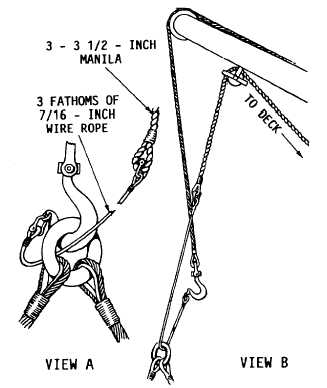| |
Figure 5-8.–Safety runner.
the ship. To do so would cause the boat to dive
against the side of the ship when the boat begins
to ride the painter, and it would probably
capsize. It is important that the sea painter be
adjusted properly and that the boat be allowed
to drop back on it so that the boat's attachment
point will be directly under the crane before
lifting. Otherwise, it may broach to and capsize
as it starts to leave the water.
Once it rides to the painter, and the slings are
attached, the boat is lifted out of the water and the engine
is secured. Steadying lines should be secured to the
cleats on the outboard side of the boat and brought back
on deck to hold the boat steady as it rises. The bow hooks
and stern hooks must fend it off the side. When the boat
is clear of the water, the engine is secured, and the plugs
should be removed (so that the bilges will drain before
the boat reaches the deck).
In operating with davits, the boat attaches to the
sea painter and the steadying lines in the same manner,
and must take the same precautions against broaching
when lifted. The falls are lowered to the boat and the
bow hook hooks the forward Raymond release hook
first (hook pointing aft). The bow hook must rotate the
block until all the twists are out of the falls before
hooking on; otherwise, a dangerous jam will occur as
the blocks draw together. Once the forward block is
hooked on, the stern hook removes the twists in the after
fall and then attaches the after Raymond release hook
(hook pointing forward). Both then secure the releasing
hooks closed by their lanyards using three figure-eights
and a half hitch. Manropes (monkey lines) are
suspended from the strongback/span wire to the boat,
and each person aboard must support part of his or her
weight on the line as the boat rises, to be ready in any
emergency.
Hard hats with chin straps and inherently buoyant
life preservers must be worn by personnel when they are
being hoisted or lowered in a boat.
ALONGSIDE SHIP OR LANDING
In operating a boat, the most important point to
remember is that the stern, not the bow, goes off track
first when the rudder is turned; the boat reacts to the
rudder much faster at high speed than at low speed.
Often, when you see that you did not allow yourself
enough room for a turn, gunning of the engine will bring
it around in time. You will have to make a judgment call
on that.
All single-screw boats have right-handed screws
turning in a clockwise direction going ahead, when
viewed from astern. For this reason, the side force of
the screw, when going ahead, tends to walk the stern
to starboard when the boat is gathering headway. This
screw action means that your boat always makes a
faster turn to port than to starboard when gathering
headway.
When backing, however, the stern tends to walk to
port, no matter how much rudder you put on to the right.
If you have to back a long stretch in a straight line, back
with a hard right rudder until you start to curve to port.
Then shift your rudder and gun your engine ahead fast.
The boat straightens itself in a second, without losing
sternway.
One of the first pointers you must learn about your
boat is how fast it will backdown. It is next to impossible
to back a boat in a straight line. You must use your rudder
and, at times, shift your engine to back your boat
because of the effect on the screw and rudder.
It is always easier to go alongside port-side-to than
starboard-side-to. See figure 5-9. The reason: When
you put your port bow alongside and start to back, the
5-9
|

